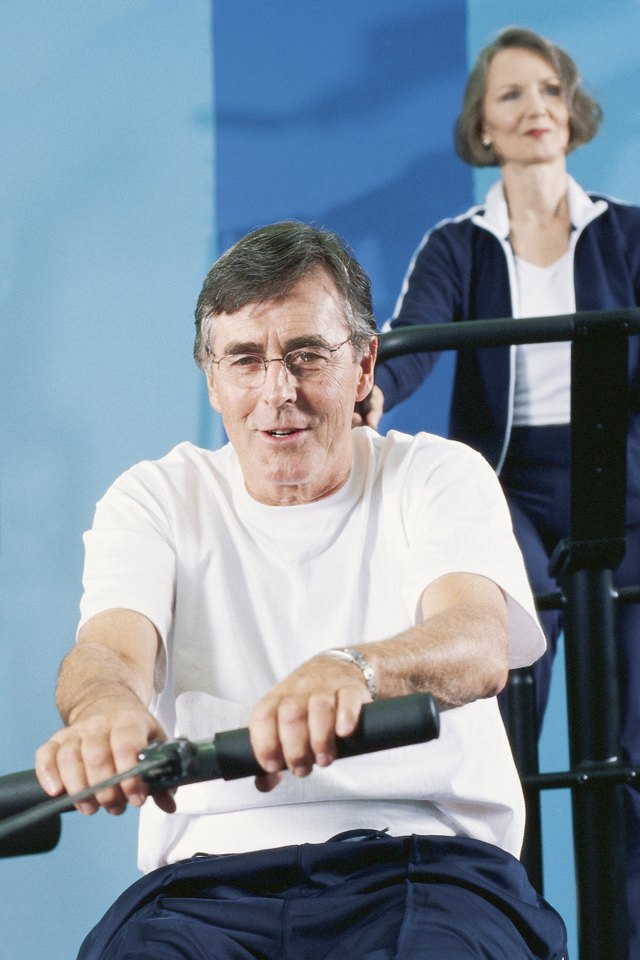How to Get Fit at 50 for Men

Turning 50 throws some new challenges into the mix as far as your fitness is concerned. With any stage of life, diet, exercise and keeping an eye on your health is important. But as you approach and pass the 50-year mark, those three elements are more important than ever. Approaching it all with a positive attitude and a determination to maintain your health and fitness will bring success.
Eat a balanced diet. That is always recommended for any stage of life and it doesn't change when you reach age 50. However, with age comes increased concerns for heart and prostate health for men. This means monitoring fat intake, which can affect your heart--especially if you have a family history of heart disease--as well as adding or increasing fiber in your diet. Fiber is good for your health on many levels, such as keeping your digestive system healthy, and according to The Cancer Project, it also prevents tumors and stops cancerous cells from spreading by clearing hormones, carcinogens and fats from your body, which is great news for your prostate.
Take a vitamin and mineral supplement especially formulated for men over 50. Along with the basic antioxidant vitamins like A, C and E, which are also good for your prostate, your supplement should include a good variety of B vitamins for energy, helping your body process nutrients and producing new cells, and vitamin H to help reduce hair loss. As for the minerals, your supplement should include calcium to help with reduced bone structure and density, chromium to maintain blood sugar levels, magnesium to regulate your heart and keep your immune system healthy and zinc for keeping your senses of taste and smell working properly. Zinc helps with the healing of wounds, too.
Talk to your doctor about keeping physically fit. Looking good is always a consideration, but as you age maintaining strength is more important than appearance. Strong muscles will support your bones as well as assure that you have the mobility to remain independent well into your golden years. Resistance training is the best way to build muscle mass. Free weights at a gym, if you have a membership or want to get one, are a great way to get in shape and build muscle at any age. If you or your doctor are concerned about possible injuries from free weights or weight machines, doing the same exercises with resistance bands is just as effective without the stress on your bones and joints. Including cardiovascular exercise is important, too, to keep your heart and lungs healthy and maintain good circulation.
Begin a regular fitness regimen. For a reasonably healthy adult male of 50 years, 30 minutes of moderate cardio activity or 20 minutes of intense activity each day is sufficient. Swimming, walking or biking are excellent examples of cardio activities. Just increase the pace to move them from moderate to intense. As for strength building, a resistance workout will be effective two days a week, but leave at least one rest day in between workouts. Do eight to 10 exercises each day. Do two sets of each exercise using light to moderate weight and perform eight to 10 reps per set. To increase the intensity level, up the resistance and do more repetitions in each set.
See your doctor regularly to stay on top of health concerns that will crop up as you reach age 50 and beyond. Prostate cancer, heart disease and depression are among the top health concerns for men 50 and older--particularly if you have a family history of any or all of them. Diet and exercise go a long way in giving you a head start on preventing these health concerns, but routinely consulting with your doctor will assure that he can address and treat these problems if they progress past the point to which lifestyle can help control them.
References
Writer Bio
Elle Di Jensen has been a writer and editor since 1990. She began working in the fitness industry in 1987, and her experience includes editing and publishing a workout manual. She has an extended family of pets, including special needs animals. Jensen attended Idaho and Boise State Universities. Her work has appeared in various print and online publications.
